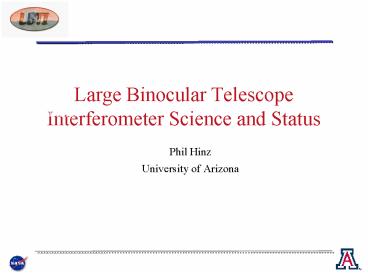Large Binocular Telescope Interferometer Science and Status - PowerPoint PPT Presentation
1 / 16
Title:
Large Binocular Telescope Interferometer Science and Status
Description:
DOCTYPE plist PUBLIC '-//Apple Computer//DTD PLIST 1.0//EN' 'http://www.apple. ... key com.apple.print.PageFormat.PMHorizontalRes /key dict ... – PowerPoint PPT presentation
Number of Views:70
Avg rating:3.0/5.0
Title: Large Binocular Telescope Interferometer Science and Status
1
Large Binocular Telescope Interferometer Science
and Status
Outline
- Phil Hinz
- University of Arizona
2
The Large Binocular Telescope
3
Goals of LBTI
- Provide sensitive nulling interferometric
observations of nearby solar-like stars (the
NIREST survey). - Provide beam combination compatible with
wide-field Fizeau (imaging) interferometry
(imagers not part of the project). - Develop the technique of nulling interferometry,
active phase control, and observing strategies. - Provide a test-bed for multi-pair nulling
techniques which can verify the optical systems
of a TPF mission.
4
A Nulling Infrared survey of Extra-solar Systems
for TPF (NIREST)
- The LBTI NIREST survey will be an important
scientific step in understanding what exists
around potential candidate stars for the
Terrestrial Planet Finder Mission (TPF). Do they
have zodiacal dust disks? Gas giant planets? - Zodiacal dust disks signal the existence of
planetary systems and provide information about
their placement. - Giant planets, similar to Jupiter, dominate the
dynamical environment of potential terrestrial
planets. As such, their existence and placement
in a planetary system are important for
determining the habitability of a system. - The survey goal is to observe 80 stars to begin
to understand what the zodiacal dust strength is
for stars as a function of their spectral type
and age.
5
Probing dust limits for stars at 10 pc
ß Pictoris
HR 4796A
? Lep
Vega BLINC MMT Observation
F0 star
Stellar flux
dust around an A0 star
G0 star
K0 star
Flux in nulled output of LBT (mJy)
M0 star
Nulled stellar flux
LBTI sensitivity requirement
Cloud density (zodis)
6
Science Results using a prototype nuller on the
MMT
HD 100546 (Liu et al. 2003, (ApJL 598, 111))
Constructive Null
- Disk approximately 25 AU in diameter.
- Disk similar in size at 11 microns and 24.5
microns. - Consistent with an inner hole? (Bouwman et al.
2003)
e Mus
HD 100546
AB Aur and V892 Tau (Liu et al. ApJL accepted)
- AB Aur Disk 32 AU.
- Disk inclined at 45 degrees.
- V892 Tau size 22 AU.
Vega (Liu et al. 2004, (ApJL 610, 125))
- Upper limit to zodiacal dust is lt2 (3 s) of the
stellar flux on Vega, 3 times more sensitive
than best photometric measurements. - Corresponds to a limit of a zodiacal dust disk
lt650 times our own.
7
LBTI Accommodates Anticipated Fizeau Imaging
- The requirements for nulling interferometry with
the LBT are consistent with the design
requirements for wide-field imaging (or Fizeau)
interferometry. - This technique allows high resolution
(0.01-0.05) imaging of even faint objects over
wide (30-40) fields of view. - The LBTI design preserves this capability over a
broad range of wavelengths in the near and mid
infrared (1-20 microns). - Fizeau imagers and phase sensing to take
advantage of this are not within the scope of the
LBTI program.
8
LBTI Imaging Sensitivity
9
LBTI Fizeau Imaging Capabilities
Fizeau imaging snapshot of Io
Reconstruction from three images
formed at 60 degree intervals resolution
appropriate for I, J, H bands (simulation by
Keith Hege)
10
The LBT Interferometer (LBTI)
11
Testing the first primary
- First light testing is currently underway
- Adaptive Secondaries will be integrated in 06.
12
The LBTI on the Telescope
13
LBTI metering structure
14
LBTI Parts 07/04
Reimaging Mirror
vacuum bellows
rough cryostat housing
Mirror being polished
cryostat housing machined
center metering structure
metering structure edge-on
15
LBTI Components 02/05
Fast Pathlength Corrector
SiC Mirror
Left UBC Cryostat
4 K Mech. Cooler
16
Conclusion
- LBTI is an important stepping stone for TPF. It
will allow NASA to verify the techniques for
planet finding and better understand candidate
target systems with the lower risks and costs of
a ground-based instrument. - The LBTI is very close in design to an
interferometric TPF needing to solve many of the
same technical problems, while avoiding those
issues unique to ground-based long baseline
interferometers. - The prototype instrument, BLINC with the MMT AO
system, is allowing us to develop a mature
technique in preparation for the LBTI.































